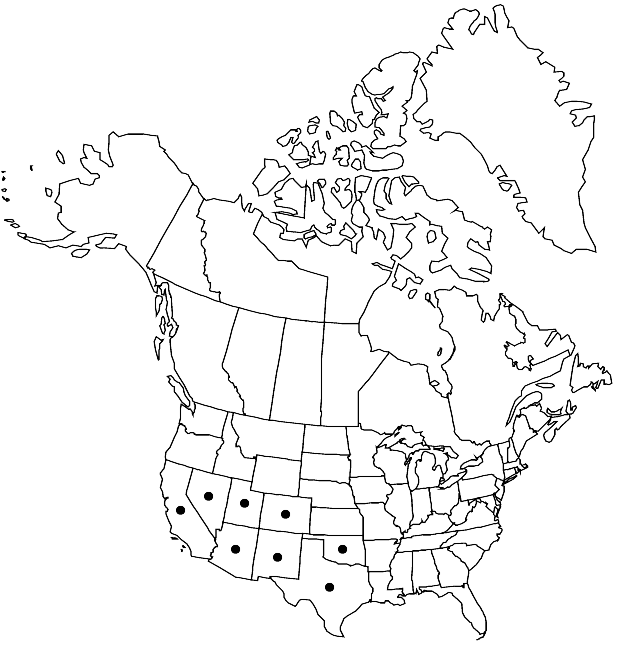Salix gooddingii
Bot. Gaz. 40: 376, plate 12, figs. 1, 2. 1905.
Trees, 3–30 m. Stems: branches flexible to ± brittle at base, yellow-brown to gray-brown, pubescent to glabrescent; branchlets usually yellowish or yellow-green, sometimes reddish brown, puberulent or pubescent to glabrescent. Leaves: stipules broad rudiments or foliaceous on early ones, foliaceous on late ones, (glands numerous adaxially), apex rounded to convex; petiole (sometimes with spherical glands distally), 4–10 mm, pilose adaxially; largest medial blade (sometimes amphistomatous), narrowly elliptic, very broadly oblong, lorate, or linear, 67–130 × 9.5–16 mm, 4.7–12.4 times as long as wide, base cuneate to convex, margins serrulate to serrate, apex acuminate, caudate, or acute, abaxial surface (usually not glaucous, rarely thinly so), glabrous or puberulent, hairs wavy, adaxial slightly glossy, pilose to glabrescent; proximal blade margins entire or shallowly serrulate; juvenile blade sparsely velvety to pilose abaxially, hairs white. Catkins: staminate 19–80 × 6–10 mm, flowering branchlet 2–23 mm; pistillate 23–82 × 6–15 mm, flowering branchlet 2–48 mm; floral bract 1.4–2.4 mm, apex acute or rounded, entire or toothed, abaxially sparsely to moderately densely hairy, hairs wavy; pistillate bract deciduous after flowering. Staminate flowers: abaxial nectary (0.2–)0.3–0.6 mm, adaxial nectary square to ovate, 0.2–0.6 mm, nectaries distinct; stamens 4–6(–8); filaments (sometimes basally connate), hairy on proximal 1/2; anthers 0.4–0.5 mm, (axes straight). Pistillate flowers: adaxial nectary square (flattened), 0.2–0.6 mm; stipe 1.2–3.2 mm; ovary pyriform, (sometimes villous), beak slightly bulged or abruptly tapering to styles; ovules 12–18 per ovary; styles 0.1–0.3 mm; stigmas 0.2–0.29–0.32 mm. Capsules 6–7 mm. 2n = 38.
Phenology: Flowering late Mar–Jun.
Habitat: Riparian forests, springs, seepage areas, washes, meadows
Elevation: -40-500(-2500) m
Distribution

Ariz., Calif., Colo., Nev., N.Mex., Okla., Tex., Utah, Mexico (Baja California, Chihuahua, Coahuila, Guerrero, Sinaloa, Sonora).
Discussion
Salix gooddingii and S. nigra are closely related and are sometimes treated as conspecific (C. R. Ball 1950). Salix gooddingii has yellow-brown or pale gray-brown branches, capsules 6–7 mm, and ovaries usually glabrous but pilose in ca. 20% of specimens. Salix nigra has red-brown to dark gray-brown branches, capsules 3–5 mm, and ovaries almost always glabrous. A single plant with pilose ovaries was found in Ontario, Canada; reports (W. A. Archer 1965) of S. nigra with hairy ovaries in Alabama, Arkansas, Illinois, Iowa, Kansas, Massachusetts, Oklahoma, and Texas could not be confirmed. Ranges of these taxa overlap in west-central Texas, where there is evidence of intergradation; they rarely occur in the same population. The map by E. L. Little Jr. (1971), who treated them as conspecific, shows a significant range disjunction between the two.
Catkins of Salix gooddingii flowering in March and early April are sometimes borne in leaf axils. This suggests that the sylleptic condition, typical of S. bonplandiana, is sometimes ecotypic.
Hybrids:
Salix gooddingii forms natural hybrids with S. amygdaloides and S. nigra. Hybrids with S. lasiandra have been reported (C. K. Schneider 1921); no convincing specimens have been seen.
Salix gooddingii × S. laevigata: In Arizona, a population of young plants displays intermediate characteristics. They have leaf blades sparsely glaucous abaxially, as in S. laevigata, but narrow, often amphistomatous, and with petioles sometimes not glandular distally, as in S. gooddingii. Both parental species occur in the region. This hybrid was also reported by C. K. Schneider (1921) from California.
Salix gooddingii × S. nigra: This hybrid may occur in western Texas where the parental species overlap. Some specimens from that area seem to be “intermediate” in branch color, but the differences are subtle.
Selected References
None.